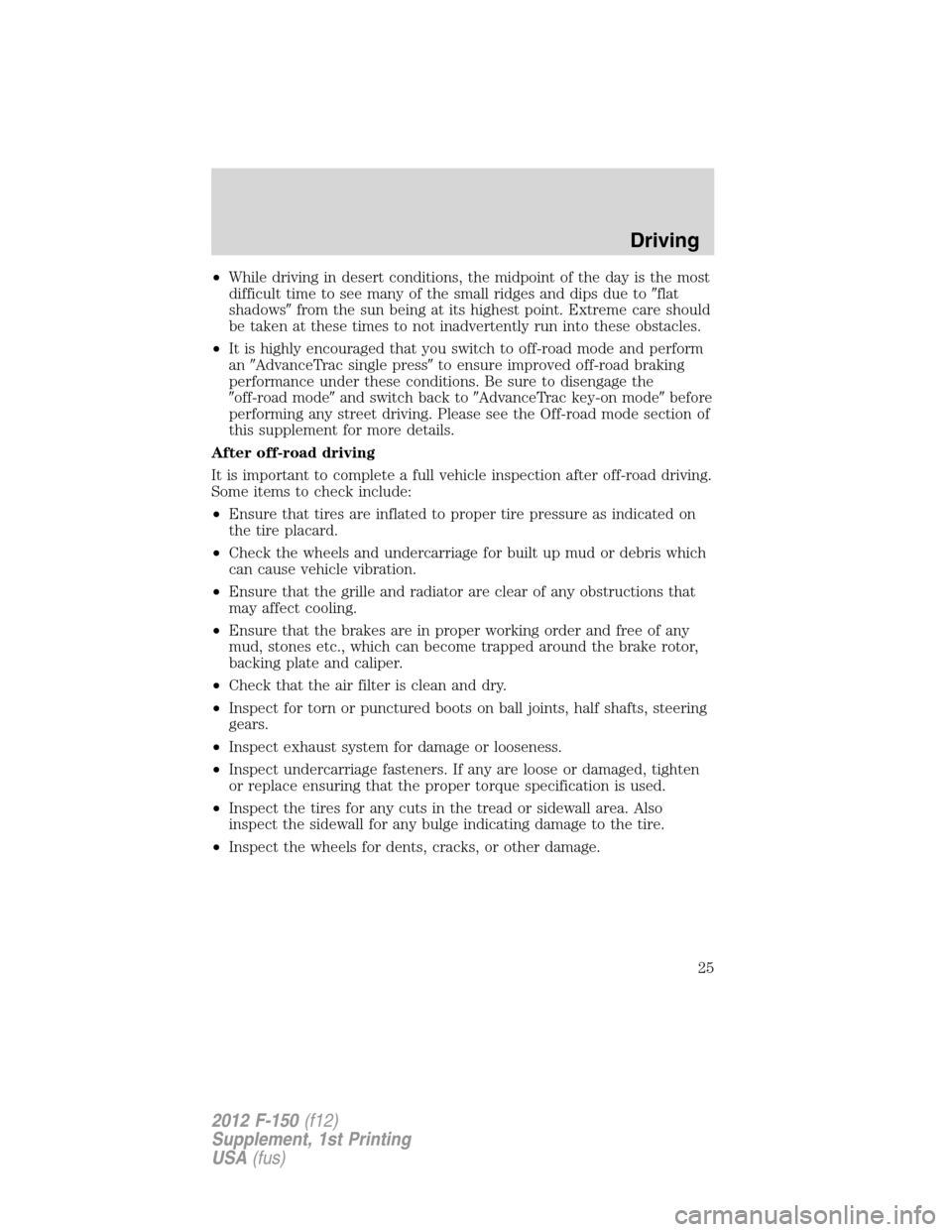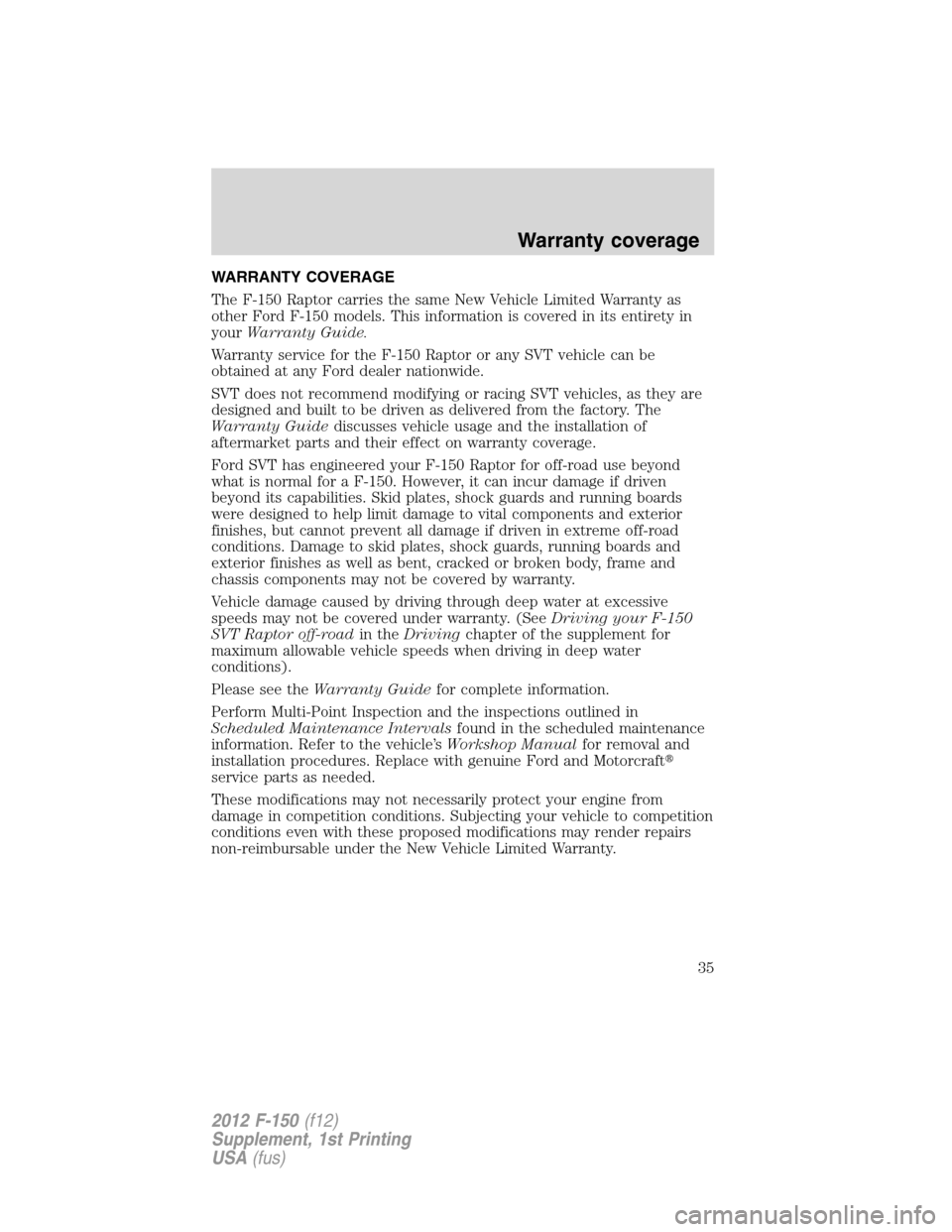Page 21 of 36

Soft sand and dunes present a very unique driving challenge. Before
going on such a drive, some research is advised regarding proven
techniques and pitfalls inherent in driving in deep sand. Some general
points to consider:
•It is very difficult and in many cases impossible to navigate deep sand
with tire pressures which are appropriate for on-road driving. If you
decide to “air down” your tires, be advised that the tire pressure
monitoring light will illuminate. The tires must be returned to normal
recommended tire pressures before driving on pavement or hard
surfaces.
•Lower tire pressures are more likely to cause a debeading of the tire
during cornering. Avoid sharp or abrupt turns when you have
extremely low tire pressures.
•To help prevent becoming stuck in deep sand, avoid spinning the tires
or making abrupt maneuvers. Proceed in a controlled manner while
maintaining vehicle momentum.
•Avoid stopping or parking on inclines as this makes it more difficult to
resume driving.
Driving in deep snow
•Maintain vehicle momentum.
•Apply the throttle very gently to avoid spinning the tires. Spinning the
tires will potentially dig the vehicle deeper into the snow.
•Drive in a controlled manner, avoiding aggressive steering wheel
movements, and keep braking to a minimum.
•Extremely deep snow may cause the vehicle to�high center�causing
the vehicle to become stuck. Test the depth of the snow before trying
to drive through it.
Crossing obstacles
•Review the path ahead before attempting to cross any obstacle. It is
best if the obstacle is reviewed from outside the vehicle so that there
is a good understanding of terrain condition both in, front of, and
behind the obstacle.
•Approach obstacles slowly and slowly inch the vehicle over.
•If a large obstacle such as a rock cannot be avoided, choose a path
that places the rock directly under the tire rather than the
undercarriage of the vehicle. This will help prevent damage to the
vehicle.
•Ditches and washouts should be crossed at a 45 degree angle, allowing
each wheel to independently cross the obstacle.
Driving
21
2012 F-150(f12)
Supplement, 1st Printing
USA(fus)
Page 25 of 36

•While driving in desert conditions, the midpoint of the day is the most
difficult time to see many of the small ridges and dips due to�flat
shadows�from the sun being at its highest point. Extreme care should
be taken at these times to not inadvertently run into these obstacles.
•It is highly encouraged that you switch to off-road mode and perform
an�AdvanceTrac single press�to ensure improved off-road braking
performance under these conditions. Be sure to disengage the
�off-road mode�and switch back to�AdvanceTrac key-on mode�before
performing any street driving. Please see the Off-road mode section of
this supplement for more details.
After off-road driving
It is important to complete a full vehicle inspection after off-road driving.
Some items to check include:
•Ensure that tires are inflated to proper tire pressure as indicated on
the tire placard.
•Check the wheels and undercarriage for built up mud or debris which
can cause vehicle vibration.
•Ensure that the grille and radiator are clear of any obstructions that
may affect cooling.
•Ensure that the brakes are in proper working order and free of any
mud, stones etc., which can become trapped around the brake rotor,
backing plate and caliper.
•Check that the air filter is clean and dry.
•Inspect for torn or punctured boots on ball joints, half shafts, steering
gears.
•Inspect exhaust system for damage or looseness.
•Inspect undercarriage fasteners. If any are loose or damaged, tighten
or replace ensuring that the proper torque specification is used.
•Inspect the tires for any cuts in the tread or sidewall area. Also
inspect the sidewall for any bulge indicating damage to the tire.
•Inspect the wheels for dents, cracks, or other damage.
Driving
25
2012 F-150(f12)
Supplement, 1st Printing
USA(fus)
Page 35 of 36

WARRANTY COVERAGE
The F-150 Raptor carries the same New Vehicle Limited Warranty as
other Ford F-150 models. This information is covered in its entirety in
yourWarranty Guide.
Warranty service for the F-150 Raptor or any SVT vehicle can be
obtained at any Ford dealer nationwide.
SVT does not recommend modifying or racing SVT vehicles, as they are
designed and built to be driven as delivered from the factory. The
Warranty Guidediscusses vehicle usage and the installation of
aftermarket parts and their effect on warranty coverage.
Ford SVT has engineered your F-150 Raptor for off-road use beyond
what is normal for a F-150. However, it can incur damage if driven
beyond its capabilities. Skid plates, shock guards and running boards
were designed to help limit damage to vital components and exterior
finishes, but cannot prevent all damage if driven in extreme off-road
conditions. Damage to skid plates, shock guards, running boards and
exterior finishes as well as bent, cracked or broken body, frame and
chassis components may not be covered by warranty.
Vehicle damage caused by driving through deep water at excessive
speeds may not be covered under warranty. (SeeDriving your F-150
SVT Raptor off-roadin theDrivingchapter of the supplement for
maximum allowable vehicle speeds when driving in deep water
conditions).
Please see theWarranty Guidefor complete information.
Perform Multi-Point Inspection and the inspections outlined in
Scheduled Maintenance Intervalsfound in the scheduled maintenance
information. Refer to the vehicle’sWorkshop Manualfor removal and
installation procedures. Replace with genuine Ford and Motorcraft�
service parts as needed.
These modifications may not necessarily protect your engine from
damage in competition conditions. Subjecting your vehicle to competition
conditions even with these proposed modifications may render repairs
non-reimbursable under the New Vehicle Limited Warranty.
Warranty coverage
35
2012 F-150(f12)
Supplement, 1st Printing
USA(fus)